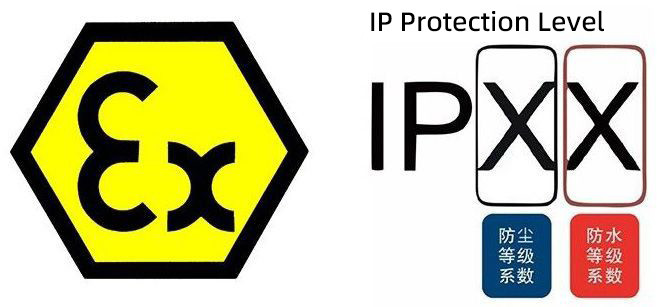Many customers often inquire about the specific parameters of protection and explosion-proof levels when purchasing explosion-proof products. However, these crucial aspects are frequently overlooked, leading to widespread confusion between the two concepts. Today, let’s clarify the distinct differences between the protection level and explosion-proof level:

Explosion-Proof: This term refers to the classification level of electrical equipment used in hazardous areas.
Protection: Relates to water and dust resistance.
Explosion-Proof Level:
For example, the explosion-proof symbol “Ex (ia) IIC T6” signifies:
| Logo content | Symbol | Meaning |
|---|---|---|
| Explosion proof declaration | Ex | Meets certain explosion-proof standards, such as China's national standards |
| Explosion proof method | ia | Adopting IA level intrinsic safety explosion-proof method, it can be installed in Zone 0 |
| Gas category | IIC | Promised to involve IIC explosive gases |
| Temperature group | T6 | The surface temperature of the instrument shall not exceed 85 ℃ |
Protection Level:
For instruments used in explosive hazard zones, it’s essential to specify the protective level of their enclosures. This is represented by the IP rating.
The first level of protection prevents human contact with live and moving parts inside the enclosure, as well as the ingress of solid objects.
The second level of protection safeguards against harmful effects caused by water entering the product.
The first digit after “IP” indicates the level of dust protection.
| Number | Protection range | Explain |
|---|---|---|
| 0 | Unprotected | No special protection for external people or objects |
| 1 | Prevent solid foreign objects with a diameter greater than 50mm from entering | Prevent the human body (such as the palm) from accidentally coming into contact with internal electrical components, and prevent larger external objects (with a diameter greater than 50mm) from entering |
| 2 | Prevent solid foreign objects with a diameter greater than 12.5mm from entering | Prevent human fingers from touching internal parts of electrical appliances and prevent medium sized (diameter greater than 12.5mm) foreign objects from entering |
| 3 | Prevent solid foreign objects with a diameter greater than 2.5mm from entering | Prevent tools, wires, and similar small foreign objects with a diameter or thickness greater than 2.5mm from invading and coming into contact with internal parts of electrical appliances |
| 4 | Prevent solid foreign objects with a diameter greater than 1.0mm from entering | Prevent tools, wires, and similar small foreign objects with a diameter or thickness greater than 1.0mm from invading and coming into contact with internal parts of electrical appliances |
| 5 | Prevent external objects and dust | Completely preventing foreign objects from entering, although it cannot completely prevent dust from entering, the amount of dust intrusion will not affect the normal operation of the electrical appliances |
| 6 | Prevent external objects and dust | Completely prevent the intrusion of foreign objects and dust |
The second digit signifies the level of water protection.
| Number | Protection range | Explain |
|---|---|---|
| 0 | Unprotected | No special protection against water or moisture |
| 1 | Prevent water droplets from soaking in | Vertically falling water droplets (such as condensate) will not cause damage to electrical appliances |
| 2 | When tilted at 15 degrees, water droplets can still be prevented from soaking in | When the appliance is tilted vertically to 15 degrees, dripping water will not cause damage to the appliance |
| 3 | Prevent sprayed water from soaking in | Prevent rain or damage to electrical appliances caused by water sprayed in directions with a vertical angle of less than 60 degrees |
| 4 | Prevent splashing water from entering | Prevent water splashing from all directions from entering electrical appliances and causing damage |
| 5 | Prevent sprayed water from soaking in | Prevent low-pressure water spraying that lasts for at least 3 minutes |
| 6 | Prevent large waves from soaking in | Prevent excessive water spraying that lasts for at least 3 minutes |
| 7 | Prevent water immersion during immersion | Prevent soaking effects for 30 minutes in water up to 1 meter deep |
| 8 | Prevent water immersion during sinking | Prevent continuous soaking effects in water with a depth exceeding 1 meter. The accurate conditions are specified by the manufacturer for each device. |
 Shenhai Explosion-Proof
Shenhai Explosion-Proof
